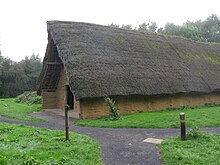Balbridia
Balbridie Hall was a large Neolithic timber house ( English Timber Hall ) in Kincardineshire in Scotland . His tracks were discovered in 1976 through aerial photographs of a field near Banchory not far from the River Dee near the B9077 road. The recordings showed a rectangular structure about 26.0 m × 13.0 m, with a number of internal structures. The house is one of the earliest known houses in Scotland and dates to around 3600 BC. Chr.
The building was excavated by N. Reynolds and Ian Ralston between 1977 and 1980 . One of the factors in the selection of the excavation site was the high resolution of the aerial photographs. The replacement of the wood testifies to the long life of the building, which dates back to around 3250 BC. Burned down.
Only a few small finds were made; Flint stones , shards of a kind of unstable ware and a few burned bones. Emmer was the most important type of cereal (80%), followed by naked barley (18%) and naked wheat ( Triticum aestivum sp. , 2%). Flax, wild oats , crab apples and hazelnuts were also found.
See also
Individual evidence
- ↑ GU-1035 to GU-1038 and OxA1767-1769, Grain
- ^ Andrew D. Fairweather, Ian Ralston: The Neolithic timber hall at Balbridie, Grampian Region, Scotland: the building, the date, the plant-macro fossils. Antiquity 67, 1993, 317
literature
- Andrew D. Fairweather, Ian Ralston: The Neolithic timber hall at Balbridie, Grampian Region, Scotland: the building, the date, the plant-macro fossils. In: Antiquity 67, 1993, pp. 313-323.
- Kenneth Brophy: From Big Houses to Cult Houses: Early Neolithic Timber Halls in Scotland In: Proceedings of the Prehistoric Society Vol. 73 2007 pp. 75-96
Web links
Coordinates: 57 ° 3 '12.8 " N , 2 ° 26' 35.7" W.

